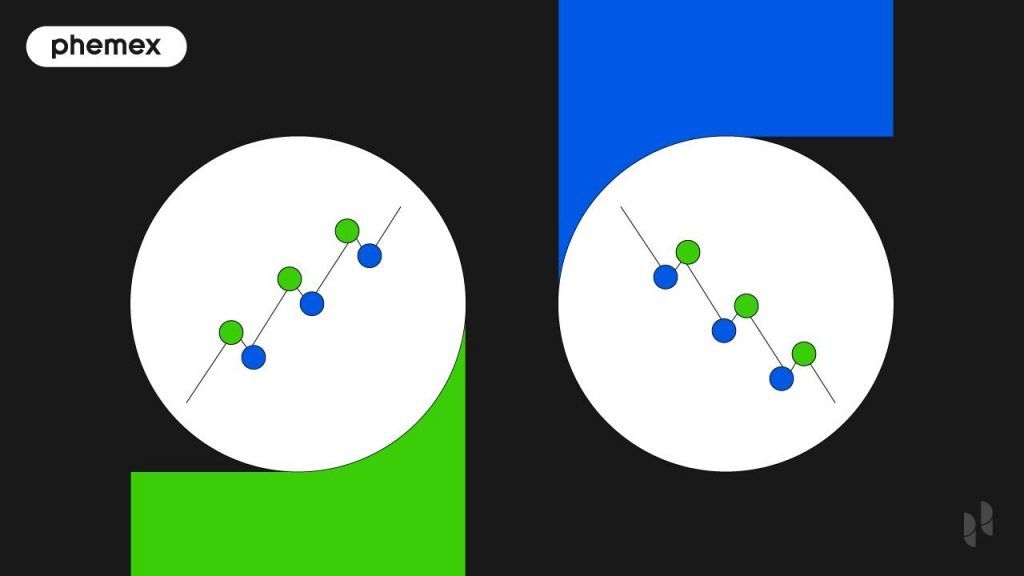Summary
- Multiple time frame analysis (MTFA) is the process of viewing the same asset’s chart under different time frames to study its long and short-term trends.
- In most cases, traders analyze three to four time frames. They are: The upper time frame, the second time frame, and the lowest time frame
- Though cryptocurrency markets are very different from stock markets, with higher levels of volatility and risk, MTFA is arguably more useful for digital assets since cryptocurrency exchanges are online 24/7.

Since the dawn of financial markets, analysts and traders have theorized, discovered, and invented new ways to track and predict asset price movements. From indicators like moving averages and oscillators to chart patterns like the “ascending triangle” and “double top,” there are numerous techniques and tools to help market participants make better decisions regarding their investments.
Trading is a risky game, especially in cryptocurrency markets, which are notorious for their extreme price fluctuations. Whether it’s a sudden increase in demand pushing prices higher or a negative rumor causing a market lull, the crypto market goes through it all – sometimes within a single day. Such price fluctuations make it difficult for traders, especially newer investors with limited experience to identify an appropriate entry point into the market and consistently time their investments to profit.
Traders are always looking for better ways to take advantage of volatility. However, it isn’t as simple as following a few sets of rules. Indicators can have conflicting predictions, and most patterns can break out both ways. With so much information available in the form of charts, patterns, and indicators, it can be overwhelming to know which tools are helpful and which ones aren’t.
This is exceptionally frustrating when the reasons behind certain price movements aren’t entirely clear, but a little perspective can work wonders for trader portfolios, and this is where market analysis tools come into play.
What is Multiple Time Frame Analysis?
One of the most commonly overlooked aspects of market analysis is looking at different time frames. Zooming in and out of the charts can help identify trends, confirm indicator signals, and predict potential price movements. This is called multiple time frame analysis. It is the process of viewing the same asset’s chart under different time frames to study its long and short-term trends.
Where is multiple time frame analysis used?
Multiple time frame analysis is used by traders of all kinds, from the average retail investor to professional cryptocurrency hedge funds, to get more clarity about the market and its trends. A trend can be either primary, intermediate, or short-term, and depending upon the time frame under consideration, can even report conflicting signals. For example, movements that look like a positive trend on a 1-hour chart can, at times, turn out to be a bearish trend when observed under longer time frame charts like, say, the 5-hour chart.
A general rule of thumb for analyzing trends is that longer time frames produce higher quality signals that are more reliable than shorter ones. As the time frame shrinks, more noise gets introduced into the charts, crowding it with false moves and signals.
How to use the Multiple Time Frame Analysis?
The upper time frame, the second time frame, and the lowest time frame
Which time frame to use depends upon what the trader aims to accomplish. In most cases, traders analyze three to four time frames, since any less could cause traders to miss out on important information, and any more could add to the noise. With three time frames, the upper time frame or the “Strategic Screen” is the broadest chart perspective and determines the overall strategy at the start of the session. The second time frame is the “Tactical Screen,” which defines the day-to-day trading strategy and comprises intermediate movements within the trend.
The lowest time frame, also called the “Executional Screen,” shows ideal points to execute trades. Most traders use this time frame when looking for patterns to refine their market entry and exit points. In a nutshell, long-term charts define the trend, intermediate charts determine the trading strategy signal, and short-term charts are used to find better market entries and exits.
Ideally, traders choose the main time frame of interest along with a higher and lower one to complement it. Long-term traders seldom discover valuable data from analyzing shorter time frames and hence rivet towards weekly or monthly time frames. Similarly, day traders needn’t bother about the long-term pattern of an asset and primarily analyze shorter time frame charts to find helpful information.
By identifying the underlying trend of a particular market, traders can quickly determine the asset’s intermediate trend. For example, though swing traders focus mainly on daily charts, they often use higher time frames like the weekly charts to understand the primary trend. Similarly, long-term traders use monthly charts to define the primary trend and a shorter daily time frame chart to select entry and exit points.
Which time frame is best for Cryptocurrency?
To determine which time frames work best, it’s essential to quantify a holding period i.e., how long the average trade is held on to. Once the holding period is determined, investors choose shorter and longer period charts based on the 1:4 or 1:6 rule, which helps calculate the time difference between different time frames.
The 1:4 rule in Multiple Time Frame Analysis
According to the rule of 4, the shorter period must be at least one-fourth of the intermediate period, which should, in turn, be one-fourth of the most prolonged period. For example, if a 24-hour period is used as an upper time frame, the 4-hour chart can be used as the intermediate time frame and a 1-hour chart for the lower time frame.
Tips when using Multiple Time Frame Analysis
One pro tip is always to follow a top-down approach when using multiple time frames. This means starting from the longest time frame before moving to the shortest one, which can help give investors a better idea of the market and make more effective decisions to capitalize on. Novice traders often make the mistake of starting their time frame analysis from the bottom-up, and while this might seem harmless in the grand scheme, it can confirm existing biases on a per-trade basis.
Different ways to use Multiple Time Frame Analysis
1. Display the charts in separate windows side-by-side
Traders can use MTFA for their trading in a couple of ways. The first is to display the charts in separate windows side by side simultaneously. This way, one can quickly analyze long-term trends before moving on to short-term ones and vice versa. The simultaneous view of both charts helps analyze them faster, giving traders more time to spend on making a better decision.
2. Looking at technical indicator values across time frames
The second method to study the charts is by looking at technical indicator values across time frames. Though this can be done by traders manually, some use software tools to simplify the analysis process, and these tools can be used to build custom directional indicators leveraging data from different charts.
3. Tracking micro-movements over smaller time frames
For newbies to the world of trading, analyzing multiple time frames can seem daunting. Some traders spend hours poring over charts before finally making a call, and in such cases, most experts suggest taking a more systematic approach. This includes beginning analysis by tracking micro-movements over much smaller time frames (say, 15-minutes), especially during market volatility, to get a clearer idea of the market’s current performance.
This is often followed by an analysis of the hourly and weekly charts to identify long-term and mid-term trends, after which traders can drill down into their findings to optimize their trading strategy using techniques like the Fibonacci analysis method.
Using MTFA when trading Bitcoin
Let’s have a look at the price of BTC across different time frames.
- (1) 15-minute timeframe

- (2) Daily chart

- (3) 6-hour chart

- (4) 1-hour chart

In the 15-minute time frame view, there’s a noticeable steady decline with a steep drop-off (Fig. 1). The market had dropped by 5%, indicated by the last three candlesticks, and an inexperienced onlooker could assume the market is going through a downward trend. However, after observing price movements across the next 6 hours (Fig. 3), it immediately shows that the original hypothesis was off since the price rose over the longer time frame despite the bearish trend signaled by the 15-minute chart.
On observing the 1-hour chart (Fig. 4), BTC dropped from $10,000 to $8,150 before gradually rising for a while, followed by another dip. This gives a broader perspective to how the market functions and shows how linked cryptocurrency prices are to market sentiment.
For the most comprehensive understanding, it’s critical to observe the daily trend (Fig 2). The red box shows how the price of BTC climbed back to cross the moving average, and the calculated assumption after observing all four time-frames predicts a high chance of BTC rebounding.
Combining multiple time frames allows traders to understand trends better than reading an independent frame. Once traders have adequately understood this concept, it’s much simpler to make informed decisions and minimize risks, making the multiple time-frame analysis an essential tool for any cryptocurrency trader.
Using Multiple Time Frame Analysis in crypto markets vs. in traditional markets
In most ways, crypto markets are very similar to conventional assets like forex, stocks, and gold. However, there are some special considerations for using the multiple time frame strategy in cryptocurrency markets.
Firstly, crypto assets have less liquidity than most assets, implying that not all timeframes will be equally helpful. For instance, with low liquidity digital assets that only trade every few days, short-term charts like the 1-minute and 1-hour charts aren’t necessarily all that useful.
The crypto market is also highly volatile, driven by all kinds of market events and speculative investments, and this can make technical analysis seem almost futile during sudden market events. As a trader, it’s crucial to stay in the know about upcoming events that could drive risk factors.
Conclusion
As mentioned above, approaching trading markets with a holistic view facilitates a better understanding of the market events. Observing the market through a single time frame is like trying to grasp a story using only a few random plot points. This only shows one side of the picture and misses out on the valuable signals from other time frames.
Adopting a more methodical approach like the multiple time frame strategy can help traders increase their odds of making a successful trade, Further, it also helps them better understand inherent biases, how the market reacts to events on different time scales, and how best to take advantage.
The multiple time frame strategy is an essential tool in any trader’s utility belt, and that’s not going to change any time soon. Though cryptocurrency markets are very different from stock markets, with higher levels of volatility and risk, the MTFS is arguably more useful for digital assets since cryptocurrency exchanges are online 24/7.
Taking signals from different time frames into account isn’t just helpful — it’s an imperative part of a professional trader’s job and is a valuable learning tool for anyone planning on trading digital assets.
Read More
- How to Read Crypto Charts: Learn Trading Chart Patterns
- Day Trading Crypto for Beginners: Get started with Day Trading
- What Is Market Timing: Trying to Find That Perfect Moment
- Crypto Trading vs. Investing: Key Differences Explained
- How To Trade Crypto: The Ultimate Investing Guide
- Which Crypto to Buy Today for Long-term & Short-term?
- TradingView: What Is It and How to Use It to Trade with Phemex
- What Is Trend Trading: Following the Market When It Pays








